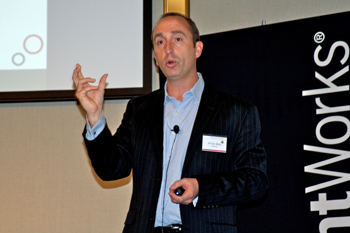Bankwest goes agile: project time slashed

update Adopting an Agile methodology for IT projects may have allowed Bankwest's developers to complete 13 months' worth of work in just 15 weeks.

CIO Andy Weir (Credit: David Braue/ZDNet Australia)
Bankwest began its shift to Agile development in 2008, when a $2.1 billion buyout by the Commonwealth Bank of Australia forced it to quickly improve its governance processes and execution capabilities.
"We had to invest massively in a real rapid mobilisation and maturing of our capabilities," CIO Andy Weir told an audience at this week's Agile Australia 2010 conference.
"Consequently, a whole corporate governance mechanism had to grow up really quickly, and get really robust and tight... It was strategically important for us to get more nimble, increase our speed to market, and continue to add value without making long-term, multi-year investments," Weir said.
Bankwest's answer was to step away from its traditional "waterfall"-styled project methodology in which project teams are given a massive roster of business requirements and deliver as many as possible through a massive, monolithic process that takes months or years and often produces suboptimal results. Instead, teams of developers and business managers were assembled to deliver projects through a series of weeks-long "sprints", each of which delivers just three or four business requirements and is continually reviewed in daily progress meetings so that obstacles can be quickly identified and resolved.
Adoption of this methodology allowed Bankwest's developers to significantly speed the delivery of a debt management project that was built earlier this year and eventually included more than 59,000 lines of code. The project went through three iterations, with a heavy emphasis on problem identification that saw more than 900 unit and functional tests run over 2100 times. This approach allowed the team to identify and remedy 106 defects during development, with a further seven identified in a subsequent sprint and remedied well before the final product was delivered.
By following the lean, accelerated schedule, Bankwest was able to deliver the project in just 15 weeks, compared with the 13 months that it was estimated the project would have taken using a conventional approach. This has been so significant that the company has this year enshrined Agile development as one of its six core business principles: within the next three years, Weir said, the company is aiming to deliver fully half of its change portfolio using Agile methodologies.
Agile's unexpected hurdles
Weir noted that Agile had introduced its share of surprises and challenges. One early surprise was the high level of Agile expertise that was already available within the company.
"We just didn't know about the kind of latent Agile capability that existed, but frankly we had never asked," he explained. "Yet in pulling together the people to make this work, we wanted to find not only the real evangelists for Agile — but the ones that had the right attitude. Just because you're excited about Agile doesn't mean you're the right person to actually work on that project. And you've got to make sure that the right business people, with the right attitude and authority to make the right decisions, are engaged."
Another surprise came when Bankwest brought in Agile consultancy ThoughtWorks to review its progress after six weeks of the Agile pilot. Weir and other company executives had become increasingly excited with the pace of progress, but were lost for words when a ThoughtWorks consultant nodded thoughtfully and asked why the Agile team was working in a "broom cupboard".
Borrowing from traditional ways of encouraging teamwork, the team had been assigned a small conference room into which the project participants would cram for their update meetings. This not only introduced "hygiene factors", but led Weir to question his own commitment to Agile.
"It came back to this point about executive sponsorship," Weir confessed. "It's not just about standing up and saying 'this is really important and we're right behind this'; frankly, I wasn't fully behind it because I wasn't providing the right tools and the right environment to let it thrive."
Bankwest refurbished a new "Agile space" complete with bright fittings, appropriate resources and 49th-floor views that have led to it being called the "Eagle's Nest" where teams now work both productively and happily.
Yet even as Bankwest gears up to bring Agile development into its herd, Weir is staring down yet another problem: although many developers were reluctant to give up old ways to embark on the Agile development, many now won't go back.
"We've now gotten to the situation where developers that were working on this Agile project are a flight risk," Weir explained. "They're saying 'don't send me back to waterfall or I'll go somewhere else'. On the one hand it's brilliant to see how wonderfully engaged they are. But if you don't have that pipeline of Agile projects stacked up, you've got a real issue and that intellectual property is going to walk straight out the door. For all the successes it provides, Agile always offers something else to think about."
Updated at 10:08am, 20 September 2010: it was reported that Bankwest had a 33rd-floor office space. The bank, in fact, occupies the 49th floor.